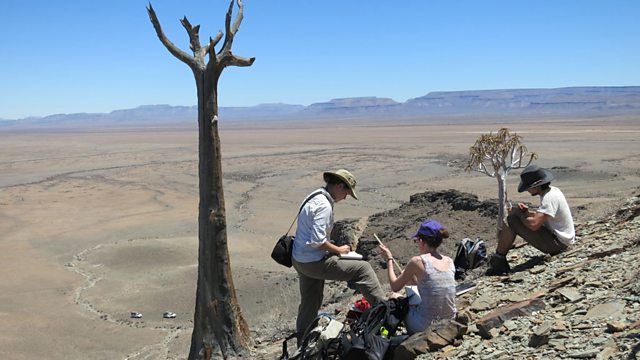Ancient Namibian Reef
Ancient Namibian reef; The amazing Titan - Saturn's largest moon; Polio in Brazil; New study to understand Snow leopards
The fossilised remains of a reef, formed from some of the earliest animals with a skeleton, have been discovered in Namibia, in southern Africa. It is 548 million years old, so it existed about eight million years before the Cambrian explosion – a time when most of the diverse forms of life on Earth appeared. The fact that these small, tubular organisms showed behaviour as complex as reef building suggests that something must have been going on, probably something that drove them to form this type of protection. Professor Rachel Wood and also Amelia Penny, both from the School of Geoscience at the University of Edinburgh in the UK came into the �鶹������ҳ���'s studios to tell us more about what these ancient reefs would have looked like, and why they are changing our understanding of the evolution of life.
The Amazing Titan
Saturn's largest moon, Titan, is one of the most fascinating places in the Solar System – second only to Earth. It has a thick, substantial atmosphere, and it has seasons. Wind and rain erode and shape the surface, and it is possible to see rivers, seas, and dunes. The mountains of Titan are formed of ice, not rock, and the lakes are filled with liquid methane and ethane. The Cassini probe is giving us glimpses of Titan as it flies by, and often providing just as many questions as answers. To discuss some of the latest findings we brought together Dr Sarah Hörst from the University of Colorado, Boulder, and Jason Hofgartner from Cornell University.
Polio in Brazil
As Brazil is flooded with visitors for the World Cup, it may be disturbing to hear that a type of Polio virus has been discovered in the country. It was found in sewage samples collected in March this year near the international airport in Campinas, near Sao Paulo. No cases have been reported, and the World Health Organisation says there is no evidence that the virus has been spread, and no travel restrictions are being imposed. Using genetic sequencing, scientists have tracked the virus back to Equatorial Guinea in West Africa, so it was probably carried in by a traveller. The Americas were declared Polio free in the early 1990s due to successful vaccination campaigns. To find out what this means for the global campaign to eliminate Polio, we spoke to Dr Jon Kim Andrus the Deputy Director of the Pan American Health Organisation.
Snow Leopards
A new project is just starting to use remote cameras to catch candid moments, and teach us more about snow leopards in the Almaty State Nature Reserve in northern Kazakhstan. Scientists are about to venture out into the wilderness to place the remote motion sensitive cameras on rocky outcrops, where they hope snow leopards will be. As well as monitoring the population, the study aims to understand the impact of climate change on the snow leopard population in Kazakhstan. Dr Ian Convery from Cumbria University is leading the team going and joins us on the programme.
(Photo: Fieldwork in the Nama Group, Southern Namibia © Rachel Wood)
Last on
More episodes
Previous
Chapters
-
Ancient Reef
The discovery of an ancient Namibian reef suggests animals evolved sooner than thought
Duration: 05:50
The Amazing Titan
The secrets of one of Saturn's moon are being revealed
Duration: 08:31
Polio in Brazil
Wild poliovirus has been found in Brazil – the first time in more than 20 years
Duration: 05:24
Snow Leopards
Taking photos of snow leopards in Kazakhstan to help protect them in the future
Duration: 05:40
Broadcasts
- Thu 26 Jun 2014 18:32GMT�鶹������ҳ��� World Service Online
- Fri 27 Jun 2014 01:32GMT�鶹������ҳ��� World Service Online
- Fri 27 Jun 2014 08:32GMT�鶹������ҳ��� World Service Online
- Fri 27 Jun 2014 15:32GMT�鶹������ҳ��� World Service Online
- Mon 30 Jun 2014 03:32GMT�鶹������ҳ��� World Service Online
Podcast
-
![]()
Science In Action
The �鶹������ҳ��� brings you all the week's science news.


